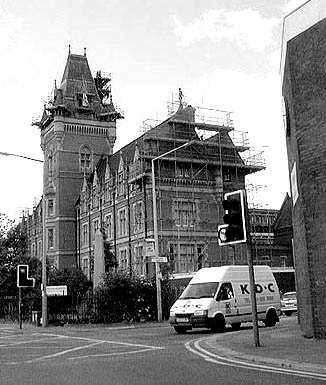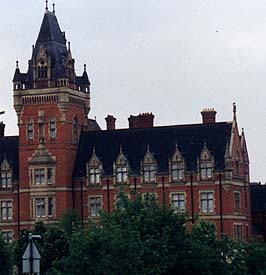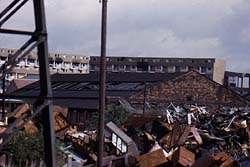|
Page One  If the first six years of life
as a comprehensive school were formative and eventful ones, so were the
following years up to the Centenary Year of 1979. Some changes took
place, others were foreshadowed, and, as always, there were problems to
be faced. Not least of these were building problems. All three
buildings were painted inside and out in their due time, new curtains
were supplied and fitted for stage and hall in "N" Building, and the
outer structure of the original part of that building was revealed in
its original splendour when cleaning was carried out, beginning in
1979. Minor difficulties caused concern, such as the lack of sports
storage space, which Mr. Porter of the Inspectorate partially solved by
arranging for an outbuilding to be erected in the "N" playground area.
Another problem was that of
staff car parking. Nicholls Street, used for that purpose earlier, was
now without houses and in disrepair, and was used by the public at
large. The space between "A" and "H" buildings was not adequate, and so
the Exeter Street area became available, with a metal barrier at the
entrance to ensure some kind of privacy. The Headmaster investigated
with the Buildings Department the possibility of open land adjacent to
Nicholls Street being made into a car park, but by 1979, it had been
developed by industry.
At times there were other more urgent problems. In February 1974, gaps appeared between window sills and window frames in some of the classrooms in the new part of "N" building. Major work had to be undertaken to repair these faults-work which meant scaffolding in the playground and the evacuation of classrooms in turn for several weeks. The Hyde Road crossing was a problem from the beginning. Staff co-operated by escorting groups which had to move and the police manned the crossing on certain occasions, mainly in out-of-teaching hours. By 1974, however, it seemed that the amounts of both traffic and commuting groups had increased and the police services were no longer guaranteed. The staff expressed their concern, and the Headmaster discussed the matter with Mr. H. Foden, Assistant Education Officer (Buildings). Eventually, Mr. A. Geraghty was appointed as porter, his duties being to man the crossings at the beginning and end of school and change of lessons when groups were crossing, assisting staff on those occasions. In times between, he performed other miscellaneous duties of supervising and portering. On Saturday afternoon, 22nd March 1975, it was reported on Radio Manchester that Nicholls Ardwick High School was on fire. When the Headmaster and Mr. R. Rigby arrived there, they found the fire brigade tackling and bringing under control a severe blaze in "A" building, which badly damaged the workshop block, a tutor's room, two classrooms, and a housecraft room above. it later transpired that the blaze had been caused by three very young children, who, unconnected with the school and living some distance from it, had climbed into the yard, forced an entry into the building and in play set fire to some inflammable material. On Sunday morning a conference was held on site with Mr. J. Hall (Deputy Chief Education Officer), Mr. R. Rigby, the Headmaster, Mr. Howard, Mr. Jones, Mr. Barnes and Mr. Allardice. Alternative classroom accommodation was found to be possible elsewhere in the school. Workmen began on Monday morning on a long repair programme which took several months. In fact, when the area was in full use again by September, certain useful modifications had been made to the Engineering Workshops room. Although some stock had been salvaged, much was lost, and boys craft work in the Upper School suffered to a certain extent.  In November 1975, a gas leak was located in the Chemistry Laboratory in "H" building. Investigations under the flooring revealed considerable seepage of water, presumably from bench sinks into the floor ducts. Repair work took several weeks. From November 1974, Mr. J. Taylor, M.E.C. Inspectorate (Mathematics and Science) had frequently discussed with Science staff some problems and needs of the laboratories in the Upper School, one of which was the need for more space in the Biology laboratory. Eventually, the former ladies staffroom, later used as a 5th year Tutor's room and an occasional M.l. room, was earmarked as a Biology preparation room, and Mr. Race, the 5th year tutor, moved over to share the 6th form Tutor's room at the other end of that corridor. In April 1977, dry rot was discovered in a part of "A" building on the Devonshire Street side, badly affecting the Science laboratory on the first floor, and the dining room hall ceiling below. The laboratory was out of use for several months and new beams and supports were inserted in the hall ceiling. Fortunately it was still possible to use "A" Gym for external examinations, although some repair work had to be done on the outside wall. Towards the end of that summer term, it was decided to demolish 62 Tiverton Street. This was no longer used for Domestic Science, being badly in need of major repairs, although it was occasionally needed in emergencies, and for external examinations. All Housecraft stock and furniture, much of it out of date, was disposed of by taking it into use elsewhere, or to M.E.C. Stores, and the house was demolished by 1978, adding slightly to the playground space. Occasionally there were "break-ins", at times very damaging to some part of the school. A serious incident occurred in "N" Building in 1978, when intruders, reaching the top floor, turned on the fire hose and caused severe flooding of laboratories and the entrance foyer, as well as other rooms. The lack of fuel oil in the winter of 1978/9 caused burst pipes and radiators and falling ceilings, with much flooding. The severe weather at that time meant that several classrooms in the main teaching block had frozen water on the floors. Pigeons, often a hazard in the tower, caused problems and for several days "N" Building could not be used, and some classes had to remain at home until heating was finally restored and the building had dried out sufficiently. The staffroom suffered badly and it was decided to use the library permanently as a staffroom, transferring all library facilities to a large classroom adjoining the playground. This meant that in the dinner break and after school, these facilities were more easily available. The original staffroom, which had always been too small, was eventually made into a television room. The resources centre continued to function effectively in its original room with a full time non-teaching assistant working closely with Mrs Leech and Mr. Rutter. By 1979, excellent video equipment was available. For several years, films had occasionally been made of certain school activities. In 1974 for example, a film was made of several sequences by the dance group. The years saw a decline in total numbers as the city population fell. On 1st September,1976, there were 533 boys and 430 girls on roll-a total of 863. compared with 1107 in September 1967. Year totals were:- 1 st year-132; 2nd year-154; 3rd year-155; 4th year-158; 5th year-183; 6th year-61; 7th year-20. The annual 1 st year intake figures remained about the same for the following years, and consequently the total dropped to 720 in September 1979. Within this changing pattern were two other relevant points. There was an increase in turnover of school population during each year. In 1974, the total of "ins and outs" (1 st to 4th year inclusive, excluding the annual September intake) was 14% of the whole. Such was the extent of population movement that by 1977, it had reached 20% and clearly was a factor not conducive to stability. Reference was made earlier to the steadily increasing total of immigrant children in school from 1967. By 1975, when the official Ministry return was discontinued, the percentage was between 20 - 21 %. An unofficial check of these multi-racial details in 1976/77 gave a figure of 33% - 139 West Indies, 66 from Pakistan,11 from India,4 from Bangladesh,10 Ugandan Asians, 3 from Kenya,1 from Burma, 8 Chinese,8 from other African countries and 33 of mixed origin. Naturally, the school was concerned to raise standards of attainment for all, and, indeed the work with immigrants was extremely successful, often attracting visitors. On one occasion the Director of School Broadcasting (North Region) visited to "sit in" with a group taking a particular programme. The industry and ability of several of those whose native language was not English was most marked, and there was a clear desire on their part to continue into the 6th Form and make the most of the opportunities afforded. Many did "A" level work very successfully, especially in Science subjects. One family of Chinese origin had 3 girls and 1 boy who took "A" levels and then proceeded to Degree or Diploma courses. Several boys and girls from India, Pakistan and Uganda gained high "A" level grades, and on occasions they were selected as Senior Students. The impact of these immigrant boys and girls on the school was certainly noticeable. They brought a broader and more cosmopolitan atmosphere into the community, and although at times there were behavioural problems and brief occasions of stress over the exercise of their minority interests and practices, yet they contributed a variety of cultural and social ideas, took part in many activities, and West Indian children especially brought much skill and enthusiasm to many school and house teams and groups. The Authority continued its policy of holding assessment tests for the 1st year pupils after about 5 months in school, and worked papers were forwarded to the Education Offices. The aim was to assess the quality of the intake and determine areas of special need. It is fair comment that the school was not getting a reasonable share of pupils of above average ability, a fact which had perturbed the staff soon after 1967. The number of contributory primary schools each year was between 40 and 50, and liaison with them all was difficult, although an effort was made to keep in touch with many of them. Mr. P. Thompson, Senior Secondary Schools Inspector continued to try to establish a closer working pattern in Mathematics between groups of Primary schools and the receiving Secondary Schools, and he visited school regularly from 1974 to discuss problems with the Mathematics department. He also visited with Mr. Bowstead, one of his colleagues, to look at the remedial work. Eventually, the Education Committee decided, as a major change in policy, to nominate a group of contributory neighbouring Primary Schools for each Secondary School, and from September 1979, the great majority if not all the entrants into the 1st year at the school were to come from the following Junior Schools:- Medlock; St. Thomas's; Ross Place; Every Street; All Saints; Nansen Street; Ashbury; Openshaw; St. Marks; All Saints (Gorton); and School of the Resurrection. 
Although it had many contributory Primary Schools, yet it began to take more and more from the neighbourhood ones. The clearance schemes in the 1960's, with the consequent building of high-rise flats, seemed to set up a less stable community. The character of the Ardwick area changed. Previously the streets of terraced houses had developed a strong community spirit; close associations were inevitable; children's street games abounded, and the corner shop was a focal point. Now the situation was different. Balcony corridors in the towering flats, covered alleyways and access areas with lifts which invited mischief, and central play areas, together with a rising tide of vandalism brought new problems of behaviour in out-of-school hours. The school had to work closely with other agencies in preventing and checking any anti-sociai behaviour if members of the school were involved. Fortunately, these occasions were not frequent. |
